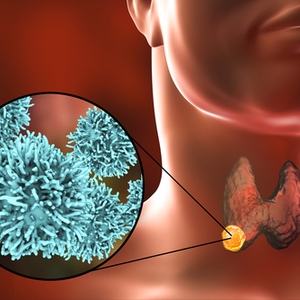
Thyroid cancer
Thyroid cancer (thyroid carcinoma) is a rather rare cancer that affects about four out of every 100,000 people in Germany every year. Women are affected three times more often than men. However, thyroid cancer only becomes noticeable when the tumour has already metastasised. This is what makes thyroid cancer so treacherous. Doctors distinguish between four types of thyroid cancer, three of which have good chances of being cured, while the fourth type is hardly treatable.
How thyroid cancer develops
Thyroid cancer is caused by degenerated cells within the thyroid gland. This happens, for example, because of a genetic change that causes once healthy cells to change into cancer cells and grow uncontrollably. Within this process, the healthy tissue is displaced and in some cases the cancer cells no longer fulfil their original function, such as the production of thyroid hormones.
The four types of thyroid cancer
The four types of thyroid carcinoma are distinguished in terms of the different types of cells in the thyroid gland:
- papillary thyroid carcinoma: is the most common type of thyroid cancer, accounting for about 80 per cent, and affects more women than men. Papillary thyroid carcinoma is characterised by its wart-like outgrowths, the so-called papillae. Papillary thyroid carcinoma often affects the lymph nodes in the neck, as it often leads to lymphogenic metastasis, i.e. the spread of cancer cells through the lymphatic system.
- follicular thyroid carcinoma: is present in about 10 per cent of thyroid cancers, making it the second most common form of thyroid cancer, affecting mainly women. Follicular thyroid carcinoma is characterised by its vesicular structures (follicular), which form in the thyroid gland. The cancer cells in follicular thyroid carcinoma often spread through the blood (haematogenous metastasis), which is why the brain or lungs are also often affected.
- anaplastic thyroid cancer: occurs in about 5 per cent of all cases and is the rarest type of thyroid cancer, affecting both men and women. Anaplastic thyroid carcinoma is hardly curable due to its rapid and aggressive growth, which is why the life expectancy of those affected is very low. However, this type of thyroid carcinoma shows symptoms after a short time, such as an asymmetric swelling of the neck area, which may be accompanied by reddening of the skin, difficulty swallowing and/or hoarseness.
- medullary thyroid carcinoma (so-called C-cell carcinoma): Just like anaplastic thyroid carcinoma, it occurs in about 5 percent of all cases in both men and women. However, unlike the other three types, medullary thyroid carcinoma does not arise from the hormone-producing thyroid cells, but from the so-called C-cells, which produce the hormone calcitonin. Calcitonin plays an important role in the regulation of phosphate and calcium balance. In medullary thyroid carcinoma, there is an overproduction of calcitonin and, as a result, a drop in the calcium level in the blood. This can lead to sensory disturbances, but also to cramps of the muscles, such as tingling of the hands. However, a typical sign of medullary thyroid carcinoma is also severe diarrhoea, which is caused by the so-called vasoactive substances produced by the tumour.
Apart from medullary thyroid carcinoma, the other three types of thyroid carcinoma originate from the so-called thyrocytes. The thyrocytes are the hormone-producing thyroid cells. Papillary, but also follicular thyroid carcinoma are so-called "differentiated" cancers. This means that the cancer cells resemble healthy thyrocytes and continue to produce thyroid hormones. Analplastic thyroid carcinoma, on the other hand, is "undifferentiated". This means that the cancer cells have lost all resemblance to thyrocytes and also no longer produce thyroid hormones.
A lump in the thyroid=thyroid carcinoma?
In contrast to the four types of thyroid carcinoma listed here, a nodule in the thyroid gland can be distinguished. In Germany, about one in four people will be diagnosed with a nodule in the thyroid gland during their lifetime. However, in most cases this is not a thyroid carcinoma, but rather a benign tumour. Although the lump in the thyroid gland can also grow uncontrollably, it does not invade surrounding tissue and is therefore very different from a malignant tumour (thyroid carcinoma).
What are the symptoms of thyroid cancer?
In most cases, thyroid carcinoma is hardly noticeable in the early stages of cancer because it does not cause any symptoms at first. Rather, thyroid cancer tends to be discovered by chance, for example during an ultrasound examination. The first symptoms appear when the thyroid cancer has already metastasised and is pressing on the trachea or oesophagus. This can be accompanied by the following symptoms:
- persistent hoarseness caused by damage to the nerves in the larynx
- Horner's syndrome, where the pupil of one eye is constricted (miosis), the eyeball is sunken (enopthalmus) and the upper eyelid droops (ptosis)
- Breathing difficulties caused by the size of the tumour inside the trachea
- Difficulty swallowing due to the tumour pressing on the oesophagus
How is thyroid cancer diagnosed?
If thyroid cancer is suspected, the doctor will first take the patient's medical history. This is followed by a physical examination in which the thyroid gland, the neck region and the lymph nodes are thoroughly palpated for suspicious changes. During a blood test, the thyroid hormones T3, T4 as well as the hormone TSH (thyroid-stimulating hormone) and possibly the calcitonin level in the blood are determined. If these values deviate from the normal values, an ultrasound examination is usually carried out. Elevated calcitonin levels usually indicate medullary thyroid carcinoma.
How is thyroid carcinoma treated?
The type of treatment depends on the type of thyroid carcinoma, but also on how far metastases have progressed in the body. In principle, an operation is possible in which the thyroid gland is either partially or completely removed (thyroidectomy). In the case of differentiated thyroid carcinoma, radioiodine therapy can be carried out. Radiation from the outside, but also chemotherapy, is usually not very effective and is therefore only used in exceptional cases.
